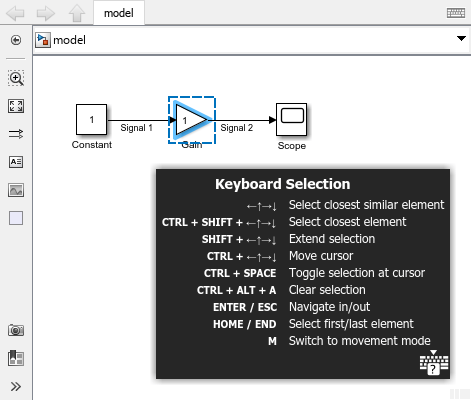Simulink 建模的键盘快捷方式和鼠标操作
在 Simulink® 中,您可以使用键盘快捷方式和鼠标操作来对系统进行建模。要从模型打开此页面,请按下 Shift+? 或点击导航栏上的键盘快捷方式  。
。
注意
当您在 macOS 上使用键盘快捷方式时:
按 command (⌘),而不是 Ctrl。
按 option 而不是 Alt。
在编辑器中查看键盘快捷方式
当您处于以下模式之一时,可以查看提示面板,该面板显示特定于活动模式的键盘快捷方式。
| 模式 | 定义 | 如何进入模式 | 如何查看提示面板 |
|---|---|---|---|
| 键盘选择 | 使用箭头键选择不同模块。 | 在模型中选择一个模块。按 M 键从移动模式(默认值)切换到选择模式。 | 当您进入选择模式时,提示面板会出现。 |
| 移动 | 用指针拖动模块来移动模块。 | 用指针拖动模块。 | 当您进入移动模式时,会出现“提示”面板。 |
| 键盘移动 | 使用箭头键移动所选模块。 | 当您打开 Simulink 时,默认处于移动模式。 要从选择模式切换到移动模式,请按 M 键。 | 当您使用箭头键移动所选模块时,将出现“提示”面板。 |
| 信号跟踪 | 跟踪信号线至信号源或目标。有关详细信息,请参阅突出显示信号的源和目标。 | 点击模型中的一个信号。将鼠标暂停在出现的省略号上。在展开的操作栏中,点击突出显示信号到信源 | 当您进入信号跟踪模式时,会出现提示面板。 |
| 平移和缩放 | 平移以在模型上移动视图。缩放以更改模型显示的远近程度。 | 当您打开 Simulink 时,默认处于平移和缩放模式。 | 按住空格键,直到提示面板展开。如果提示面板已最小化,请按住空格键直到 ? 按钮 要隐藏提示面板,请点击画布。 |
| 调整大小 | 更改模块的大小。 | 在模块大小调整控制柄上暂停。 | 当您进入调整大小模式时,将出现“提示”面板。 |
要最小化该提示面板,请按键盘上的 ? 键。当提示面板处于最小化时,只有 ? 按钮  可见。
可见。
要还原该提示面板,请按键盘上的 ?。
在一种模式下最小化或还原提示面板不会影响其他模式下的提示面板。在各个 MATLAB® 会话中,展开的提示面板保持展开状态,最小化的提示面板保持最小化状态。
例如,要查看选择模式下的键盘选择提示面板,请执行以下操作:
在模型中选择一个模块。
按 M。最小化的提示面板出现在模型窗口的右下方。
要还原该提示面板,请按键盘上的 ?。

执行文件和剪贴板操作
| 任务 | 快捷方式 |
|---|---|
| 打开模型 | Ctrl+O |
| 创建模型 | Ctrl+N |
| 打印模型 | Ctrl+P |
| 将所有修改的模型保存在当前模型层次结构中 | Ctrl+S |
| 保存当前引用模型 | Ctrl+Shift+S |
| 关闭模型 | Ctrl+W |
| 剪切 | Ctrl+X |
| 复制 | Ctrl+C |
| 粘贴 | Ctrl+V |
| 撤消 | Ctrl+Z |
| 重做 | Ctrl+Y、Ctrl+Shift+Z (Simulink Online™) |
| 查找搜索字符串 | Ctrl+F |
缩放和平移
| 任务 | 快捷方式和操作 |
|---|---|
| 使图适合窗口 | 空格键 |
| 使所选内容适合窗口 | 空格键 + F |
| 放大 | Ctrl+加号 (+) 或空格键+加号 (+) |
| 缩小 | Ctrl+减号 (-) 或空格键+减号 (-) |
| 缩放至 100% | Ctrl+0、Alt+1 或空格键 + 0 |
| 使用滚轮缩放 | 滚轮 Ctrl + 滚轮(当滚轮控制缩放处于清除状态时) |
| 放大模型元素 | 将选项板上的缩放按钮  拖放到元素上。 拖放到元素上。 |
| 在模型窗口中查看可见的模块图部分,并用微型地图显示可见部分相对于完整模块图的缩略表示 | 缩放或平移到模型的一部分。 当只有模型的一部分可见时,按住空格键,直到微型地图出现。 |
| 查看模型的不同部分 | 点击微型地图中的目标位置。 |
| 平移 | 拖动微型地图中突出显示的区域。 用鼠标中键拖动。 空格键 + 拖动。 当显示滚动条时,要用键盘移动滚动条,请按空格键 + 向左、向右、向上或向下箭头。 |
| 垂直平移 | Ctrl + 滚轮 |
| 水平平移 | Shift + 滚轮 |
| 逐页平移 | Shift + 空格键 + 向左、向右、向上或向下箭头 |
导航模型
| 任务 | 快捷方式和操作 |
|---|---|
| 打开模型 | 双击。 Enter |
| 更改选项卡 | Ctrl+Shift+Tab |
| 输入所选子系统、引用模型或 Stateflow® 图 | Enter |
| 转至所选子系统、引用模型或 Stateflow 图的父级 | Esc |
| 转至模型层次结构导航历史记录中最后查看的组件 | Ctrl+[ |
| 转至模型层次结构导航历史记录中下一个查看的组件 | Ctrl+] |
| 在模块封装下查找 | Ctrl+U |
| 对于链接模块,转至父模块的库 | Ctrl+L |
| 打开模型资源管理器 | Ctrl+H |
选择并移动模型元素
选定元素具有蓝色实线轮廓。除了轮廓之外,最近选择的元素还有蓝色角框。当您使用键盘进行选择时,为了表示光标,元素周围有蓝色虚线框。

默认情况下,模型处于移动模式。要切换到选择模式,请按 M。
| 任务 | 快捷方式和操作 |
|---|---|
| 在移动模式和选择模式之间切换 | M |
| 选择所有模块、信号线和注解 | Ctrl+A |
| 清除所选内容 | Ctrl+Alt+A |
| 选择一个或多个模型元素 | 在要选择的模型元素周围绘制一个选择框。在画布上的一个空点处开始绘制选择框。 |
| 移动任何模型元素,包括信号标签 | 拖动元素。 |
| 移动选定元素 | 拖动选定元素之一。 拖动以形成一个选择框。 使用键盘选择元素后,在选择模式下,按向左、向右、向上或向下箭头。 |
默认情况下,当您移动具有三个或更多端口的模块或调整其大小时,连接到具有一个或两个端口的模块的信号线的形状不会更改。相反,连接的模块会移动。 关闭该功能。 | 移动模块或调整模块大小时按住空格键。 当您释放空格键时,该功能将重新打开。 |
| 将所选内容改为在某个方向上向最接近的相似元素 | 在选择模式下,按向左、向右、向上或向下箭头。 |
| 将光标移至某个方向上最接近的元素,而不考虑相似性 | 在选择模式下,按 Ctrl+Shift + 向左、向右、向上或向下箭头。 |
| 将所选内容改为画布左上角的元素 | Ctrl+Home 在 macOS 上,按 home 键。 |
| 将所选内容改为画布右下角的元素 | Ctrl+End 在 macOS 上,按 end 键。 |
| 将所选内容改为相对于光标最左侧的元素 | Home 在 macOS 上,按 control+left 键。 |
| 将所选内容改为相对于光标最右侧的元素 | End 在 macOS 上,按 control+right 键。 |
| 选择其他相邻元素 | 要使用键盘选择其他相邻元素,请在选择模式下按 Shift + 向左、向右、向上或向下箭头。 要使用指针选择其他相邻元素,请按住 Shift 的同时,在其他元素周围拖动以形成一个选择框。 |
| 选择不相邻的其他元素 | 要使用键盘选择其他元素,请在选择模式下,按 Ctrl + 向左、向右、向上或向下箭头,并导航到要选择的元素。然后,通过按 Ctrl + 空格键将该元素添加到所选内容中。 在 macOS 上,要将当前元素添加到所选内容中,按 command+shift + 空格键或 shift + 空格键。 要使用指针选择其他元素,请按 Shift 并点击。 |
| 将模型元素的移动限制在垂直和水平方向 | 开始拖动元素,然后按 Shift。 |
添加和编辑模型元素
| 任务 | 快捷方式和操作 |
|---|---|
| 打开或隐藏属性检查器 | Ctrl+Shift+I 在 macOS 上,按 command+option+O 键。 在 R2023b 之前的版本中: 在 macOS 上,按 command+shift+I 键。 |
| 打开或隐藏组件接口视图 | Ctrl+Shift+V (自 R2024b 起) |
| 打开或隐藏类型编辑器 | Ctrl+Shift+P (自 R2023b 起) |
| 为所选模块设置主要参数 | Alt+Enter |
| 使用快速插入菜单将模块添加到模型的当前位置 | 双击 Simulink 编辑器画布并开始键入模块名称;然后从菜单中选择模块。 按 Ctrl+句点 (.) 两次并开始键入模块名称,然后按向下箭头从列表中选择模块,再按 Enter 键插入模块。 在 AZERTY 键盘上,按 Ctrl+Shift+句点 (.) 而不是 Ctrl+句点 (.)。 |
| 选择要连接到信号线的模块 | 将指针移到信号线未连接的一端。当指针位于信号线的一端时,它会变为一个圆圈。双击信号线的一端。使用出现的快速插入菜单,添加一个模块。新模块连接到您双击的信号线的一端。 有关如何使用快速插入菜单的信息,请参阅使用快速插入菜单向模型添加模块。 |
| 打开库浏览器 | Ctrl+Shift+L |
| 使用快速插入菜单将注解添加到模型的当前位置 | 双击 Simulink 编辑器画布并键入注解内容,然后选择注解选项。 按 Ctrl+句点 (.) 两次并键入注解内容,然后使用向下箭头选择注解选项,再按 Enter 键插入注解。 在 AZERTY 键盘上,按 Ctrl+Shift+句点 (.) 而不是 Ctrl+句点 (.)。 |
| 复制所选模型元素 | 用鼠标右键拖动元素。 Ctrl + 拖动。 |
| 在 Simulink 编辑器窗口之间复制所选模型元素 | 在窗口之间拖动元素。 |
| 删除所选模型元素 | Delete 或 Backspace |
连接模型元素
| 任务 | 快捷方式和操作 |
|---|---|
| 用信号线连接模块 | 点击端口。点击您要连接的兼容端口附近出现的蓝色向前符号 选择第一个模块,然后按住 Ctrl 键并点击第二个模块。 从端口拖动到端口。 点击一个端口,在连接到下一个端口时按住 Shift 键。按住 Shift 键连续建立多个连接。 |
| 建立信号线分支 | 点击一个端口,将光标移至要分支的信号线的附近,然后看到预览后点击。 选择一个信号线,将光标移向要连接的元素,然后点击出现在端口旁边的蓝色向前符号 Ctrl + 拖动信号线。 鼠标右键 + 拖动。 |
| 将端口添加到接受多个输入的模块 | 从兼容的模块或信号线向端口拖动。 从要添加端口的模块的边拖动。 点击端口的边,然后拖动。 点击端口的边,将光标移至菜单上的信号(类型包括信号、总线或连接线)上,然后拖动。 |
| 对所选模块断开连接 | 按下 Shift,然后拖动模块。 用键盘选择模块后,按 M 键,然后按 Shift + 向左、向右、向上或向下箭头。 |
| 注释直通所选模块 | Ctrl+Shift+Y |
| 注释掉或取消注释所选模块 | Ctrl+Shift+X |
命名模型元素
| 任务 | 快捷方式和操作 |
|---|---|
| 重命名所选模型元素 | 点击或双击标签。 选择元素,然后按 F2。 在 macOS 上,按 command+return 键而不是 F2 键。 |
| 命名信号线 | 双击信号并键入其名称。 |
| 在命名的信号线的分支上显示名称 | 双击分支。 |
| 命名信号线的每个分支 | 右键点击该信号,选择属性,然后使用“信号属性”对话框进行操作。 |
| 删除信号标签和名称 | 删除标签中的字符,或者在“信号属性”对话框中删除名称。 |
| 只删除信号标签 | 右键点击标签,然后选择删除标签。 |
| 复制信号标签 | Ctrl + 拖动信号标签。 |
| 编辑子系统模块上的端口标签 | 指向端口标签,然后点击交互式提示(标签周围的蓝色框)。 选择端口。点击端口标签提示或按 F2。 编辑信号端口上的标签时,要在模块名称和信号名称之间切换,请按 Ctrl+1、2。 要连续对子系统模块进行端口标签编辑,请执行以下操作:
|
设置模块图的格式
| 任务 | 快捷方式和操作 |
|---|---|
| 自动排列模型 | Ctrl+Shift+A |
| 调整模块大小,同时保持高宽比 | Shift + 拖动控制柄 |
| 以中心为基准点调整模块大小 | Ctrl + 拖动控制柄 |
| 在模块周围绘制信号线 | 绘制时按住 Shift 键并拖动 |
| 顺时针旋转模块 | Ctrl+R |
| 逆时针旋转模块 | Ctrl+Shift+R |
| 翻转模块 | Ctrl+I |
| 根据选择创建子系统 | Ctrl+G |
| 从空选择区创建子系统或区域 | 要创建突出显示的选项(您可以使用箭头键或鼠标对其进行更改),请执行以下操作:
按下与选项相关联的数字键。 |
| 更改信号标签字体 | 选择信号线(不是标签),然后在格式选项卡上,点击字体属性按钮箭头,然后点击模型字体。 |
| 封装模块 | Ctrl+M |
| 刷新 Model 模块 | Ctrl+K |
执行一般操作
| 任务 | 快捷方式和操作 |
|---|---|
| 使用快速操作搜索菜单执行一般操作 | 双击 Simulink 编辑器画布,选择操作选项卡,并开始键入操作名称或描述,然后从列表中选择操作。 按 Ctrl+句点 (.) 并开始键入操作名称或描述,然后按向下箭头选择操作,再按 Enter 键执行操作。 在 AZERTY 键盘上,按 Ctrl+Shift+句点 (.) 而不是 Ctrl+句点 (.)。 |
| 执行上下文相关操作 | 在打开快速操作搜索菜单之前,请选择模型元素。 |
仿真和更新模型并为其生成代码
| 任务 | 快捷方式 |
|---|---|
| 开始仿真 | Ctrl+T 或 F5 键 |
| 停止仿真 | Ctrl+Shift+T |
| 更新模型 | Ctrl+D |
| 打开“配置参数”对话框 | Ctrl+E |
| 构建模型(用于代码生成) | Ctrl+B |
调试仿真
自 R2023b 起
表中的键盘快捷方式在 Simulink 编辑器、Stateflow 编辑器和 MATLAB Function 模块编辑器中相同。
| 任务 | 快捷方式 |
|---|---|
| 越过 | F10 在 macOS 上,按 shift+command+O 键。 |
| 步入 | F11 在 macOS 上,按 shift+command+I 键。 |
| 步出 | Shift+F11 在 macOS 上,按 shift+command+U 键。 |


